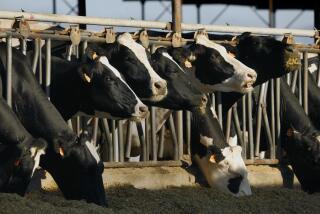Chicken run
If we’re going to eat eggs, I think the chickens that lay them should be able to stretch their wings, stand up and turn around, and not be caged. So I buy cage-free eggs, and I’m not alone. Demand for these eggs has outpaced supply in the last few years.
Now the Humane Society of the United States wants to make this choice the law in California. It has led a successful effort to put an initiative on the November ballot. If passed, the Prevention of Farm Cruelty Act would ban some livestock confinement systems. Sounds like a no-brainer. But I’m not certain I’ll vote yes.
The ban is broad. Along with so-called battery cages -- the stacked wire enclosures where nearly 95% of laying hens live out their short lives six to eight to a cage -- it would include veal crates for calves and gestation crates for sows. But California produces little veal and few pigs, so promoters and opponents view the initiative as mainly aimed at poultry cages.
Arizona and Florida have passed similar measures, but the California vote is seen as the beginning of a national push by the Humane Society to phase out battery cages.
Unfortunately, a California ban may carry unintended costs for the environment. That’s why some environmental organizations have shied away from endorsing the measure.
California’s egg industry, like the nation’s, is heavily consolidated. According to the United Egg Producers, a trade association, about 30 farms produce most of the state’s annual 5-billion-egg harvest. That’s an average of more than 600,000 hens per farm.
Farms -- factories, really -- with that many chickens can daily produce more than 21,000 gallons of manure and 500 pounds of ammonia. Manure can be a valuable fertilizer, but on this scale it’s more of a liability -- pollution that can overload waterways with nutrients, antibiotics and heavy metals.
And then there is the energy needed to run and heat the barns and to haul the eggs -- and the manure -- long distances. At the 600,000-hen scale, it’s the equivalent of more than 200,000 gallons of gasoline a year.
Further, cage-free isn’t the same thing as free-range. The label does not ensure that chickens can get outdoors. The European Union passed a cage ban in 1999, to go into effect in 2012. What many European producers making the transition have done -- and almost certainly what their California counterparts would do -- is to continue keeping chickens in huge barns, just without the cages.
This would require more barn space for each hen. Producers could enlarge their barns or house fewer chickens; both use more energy per hen. And the second option could inadvertently re-categorize some producers as “small” operators, which fall under less-stringent federal water pollution standards. Egg companies also could move to other states or to Mexico, where pollution or animal welfare standards are more lax. These outcomes could mean a bigger carbon footprint, or more pollution, or both.
So should we vote no? It’s hard to say. As with so many other environmental issues, the ethics are murky, like the tule fog that settles over the Central Valley egg factories.
But there are small things we can do that might be more meaningful than a cage ban. The eggs I buy come from hens raised free-range on pasture. Their manure fertilizes vegetables on the small farm where they live. And the chickens -- if the deliciousness of their eggs is any indication -- seem content. Do these eggs cost more? Of course, but that seems a small sacrifice given the benefits.
If we want our chickens and other livestock to live in decent conditions, we need a more radical change to our food system than this, or any ballot initiative, can deliver. The problems in industrial agriculture -- and their solutions -- are much bigger than simply banning battery cages.
More to Read
Sign up for Essential California
The most important California stories and recommendations in your inbox every morning.
You may occasionally receive promotional content from the Los Angeles Times.










